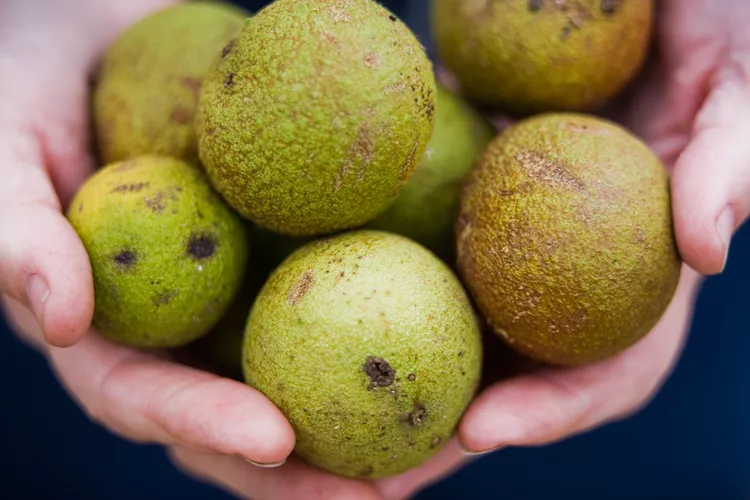Wondering if you can eat a black walnut from a tree in your yard or foraged from the woods? The answer is yes, but first, you need to know how to harvest black walnuts and crack their tough shells. Use these simple harvesting tips to enjoy these native nuts as a snack or as a flavorful addition to baked goods.
What Are Black Walnuts?
Closely related to the more common English walnut tree, the eastern American black walnut tree (Juglans nigra) grows in Hardiness Zones 4-9, where it produces nuts with a rich, distinct flavor. Rich in healthy fats, fiber, and antioxidants, black walnuts are worth the effort required to harvest the coveted nutmeats.
When to Harvest Black Walnuts
Encased in a thick green husk, ripe black walnuts begin falling from the large, high-branched trees in September and October. Be ready to race the squirrels when it's time to harvest walnuts.
The hefty nuts can dent cars as they fall off the tree and may leave black stains on hard surfaces. Avoid walnut headaches—literally and figuratively—by parking far from this tree’s canopy and gathering the fruit quickly after it falls.
Harvesting Tips
1. Gather black walnuts promptly.
Pick up fallen fruit daily to prevent squirrels from nabbing the nuts first. Gathering from the ground presents no problems, and the nutmeat is not harmed in the fall. Black walnuts still on the tree can also be harvested with the help of a hook on a long pole.
As the walnut husk deteriorates, it turns black and soft. Blackened walnut husks will stain concrete and landscape stone. Gather the walnut fruit immediately to prevent this staining. Protect your hands from the stubborn black substance by wearing gloves when harvesting the nuts.
2. Remove the husk right away.
Shortly after harvest, remove the green husk, or thick outer covering, around a black walnut. If it isn't removed before it turns black and decomposes, the husk will stain the nutmeat and give it an off-flavor. Removing the husks is time-consuming and messy, but the flavor of the nutmeat is worth the labor.
There are two common methods for removing black walnut husks:
- Pile the walnuts on a hard surface that you don't mind staining. A gravel driveway or out-of-the-way concrete pad is an option. Then, drive over the nuts repeatedly with a riding lawn mower or a car. The weight of the vehicle cracks the husk without harming the nutmeat. Then, you can peel it off like a citrus peel.
- Pound the fruits through holes cut in plywood. Drill a 1 5/8-inch diameter hole in thick plywood. Place the walnut over the hole and use a hammer to force the nut through the opening, shearing off the husk in the process.
After removing the walnut husks, wash the nuts in a large tub of water. Stir the nuts in the tub to dislodge debris and remove lingering husk material. Walnuts with good nutmeat sink to the bottom of the tub, while walnuts with unfilled or undeveloped nutmeat float. Discard all floating walnuts.
3. Let the nuts cure.
After the husks are removed, black walnuts need to dry or cure in a cool, dry, well-ventilated area for at least two to three weeks to let the nuts’ flavor develop. Spread walnuts in a single layer on trays or screens for maximum air circulation. Protect the drying nuts from squirrels and other critters. Place thoroughly dry nuts in mesh bags or baskets until you are ready to crack them.
4. Have patience when cracking walnut shells.
Cracking open a black walnut shell to retrieve the nutmeat can be a test of endurance and skill. Traditional nutcrackers are no use when it comes to black walnuts. A hammer or a vise that can apply steady pressure is much more likely to reveal the tasty nut. If you opt for a hammer, put the nuts into an old pillowcase first to help contain broken shell pieces.
Soften black walnut shells by soaking them in water for one to two hours. Remove the nuts from the water and keep them moist by storing them in an airtight container overnight. Crack the softened shells the next day.
After cracking black walnut shells open, use tweezers or needle-nose pliers to pull the nutmeat out of the craggy shells. It is common for bits of shell to break off as you remove the nutmeat. Carefully separate shell bits from the nuts.
Sometimes well-dried walnuts will develop a crack along the shell's seam. If you want to salvage larger pieces of the nuts, look for the shells with this crack. Then carefully use a thin blade such as a pocket knife to split open the two halves.
5. Store black walnuts in the fridge or freezer.
Allow shelled nuts to dry for one to two days at room temperature before transferring them to a sealed container. Store black walnuts in the refrigerator for a month or in the freezer for two years or more.




















